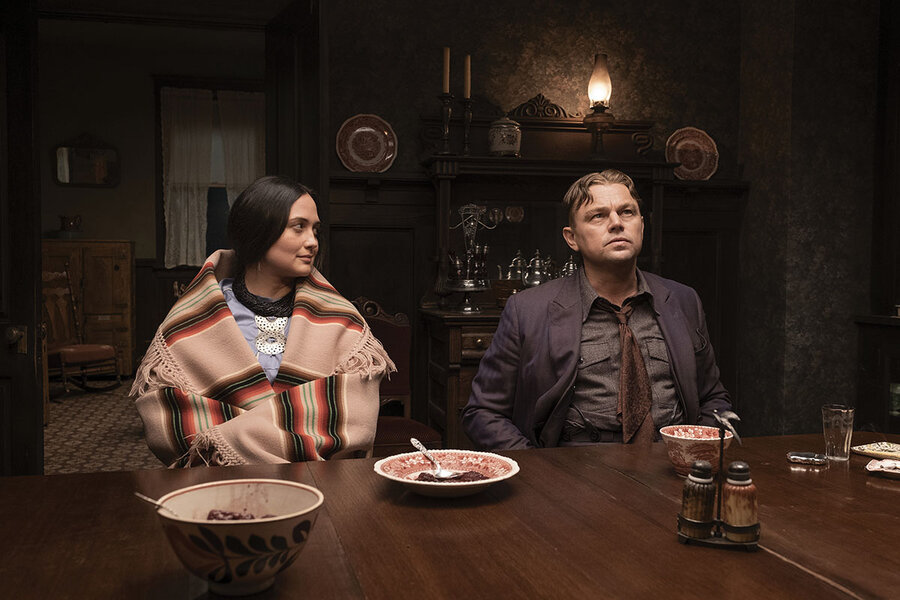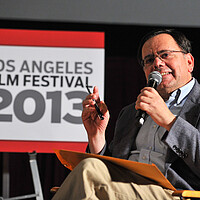‘Flower Moon’: A true tale of oil, Native rights, and murder
Loading...
Native Americans in Hollywood movies have so often been villainized or marginalized or otherwise erased from history that, even now, in our supposedly enlightened era, the appearance of a movie that attempts to right the wrong can seem groundbreaking.
This partly explains much of the anticipation surrounding the new Martin Scorsese film, “Killers of the Flower Moon,” starring Leonardo DiCaprio, Robert De Niro, and Lily Gladstone. The director’s celebrated career spans many decades and genres, but this is his first Western. Clearly he, along with his co-screenwriter Eric Roth, intends it to be a genre-bending corrective. It’s an anti-Western Western with a grievous, true-crime story to tell.
An honorable try, the movie nevertheless doesn’t fully capture the enormity of the tragedy. At best it’s a sorrowful, necessary dirge. Other times, it’s like “Goodfellas” on the range but, understandably, without the spring-coiled momentum of that film.
Why We Wrote This
In the early 20th century, the Osage tribe became the richest people on Earth. What happened next is a heartbreaking story of greed, betrayal, and conspiracy that reverberates down the decades.
Based on the propulsively readable 2017 David Grann bestseller of the same name, the almost 3 ½-hour movie methodically lays out a murderous injustice. The Osage people, forced by the federal government in the 1870s to relinquish their ancestral homeland in Kansas, suddenly became the richest per capita people on Earth in the early 20th century after oil was discovered beneath the rocky Oklahoma terrain to which they had been exiled.
The boom times were fraught from the start: White authorities attempted to control the Native Americans’ access to the money that, by rights, was legally theirs. Because those rights were passed down through an ancestral trust, the white men who married Osage women were in line for an inheritance.
Before long, an inordinate number of these women, as well as Native American men, disappeared or died from mysterious illnesses or were murdered. Investigations into the crimes were haphazard: White sheriffs, doctors, and undertakers didn’t much care. It was only when the tribal councils pressured the Bureau of Indian Affairs in Washington, D.C., that action was finally taken by what would later become known as the Federal Bureau of Investigation. (Wisely, the film downplays the white savior aspects of that intervention.)
The movie revolves around its three main protagonists: wealthy cattle rancher William “King” Hale (De Niro); his nephew Ernest Burkhart (DiCaprio), recently returned from World War I and eager to make money; and Mollie Kyle (Gladstone), the wised-up but caring Osage woman he marries.
At first I thought De Niro, often most at home in urban roles, was miscast as a Southwestern cattle baron. But he’s entirely believable. He never overdoes the man’s towering duplicity. When this potentate says of the Osage Nation that they are “the finest and most beautiful people on Earth,” he makes you believe in his sincerity against all reason. Gladstone, who was raised in Montana on the Blackfeet Reservation, gives the film’s finest performance. Though the role is too small, her Mollie is the story’s moral core. She knows that Ernest is interested in her money, but she also loves him, or at least the idea of loving him. Her widening horror at what is happening all around her pours right through her eyes.
The film founders with DiCaprio. His Ernest is a jut-jawed, not very bright man irreparably torn by greed. For me, DiCaprio, now pushing 50, nevertheless almost always seems too callow, too green, for the roles he’s called upon to play, especially in his many Scorsese films. (He was fatally miscast as Howard Hughes in “The Aviator.”) He can’t carry the psychological complexity of the part. How does Ernest really feel about Mollie, his uncle, the murders? There simply aren’t enough emotional levels to his performance to engage these questions.
As I left “Killers of the Flower Moon,” I thought that a more ferocious film could have been made if the Native Americans, and not white movie stars, occupied its center – if Mollie and her people, instead of being an adjunct to the horror, acted as our eyes and ears. For all his gifts, Scorsese hasn’t bent the genre enough.
Peter Rainer is the Monitor’s film critic. “Killers of the Flower Moon” is rated R for violence, some grisly images, and language.








